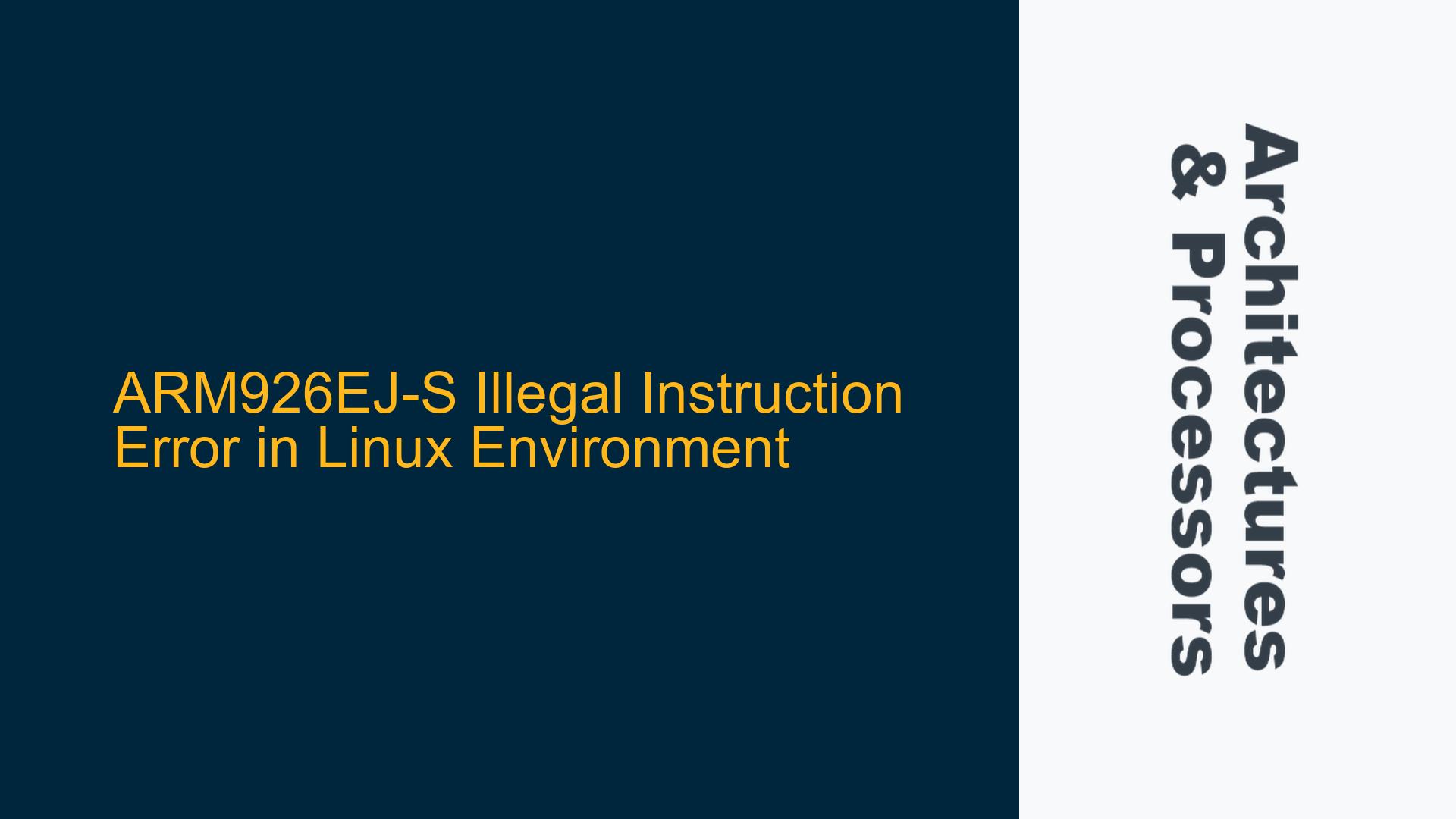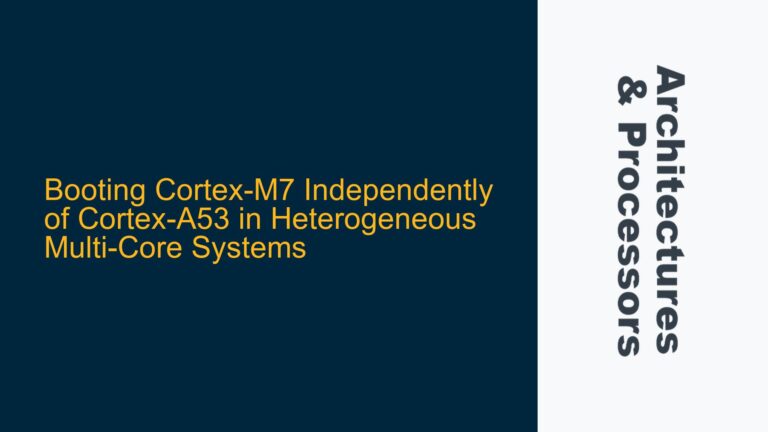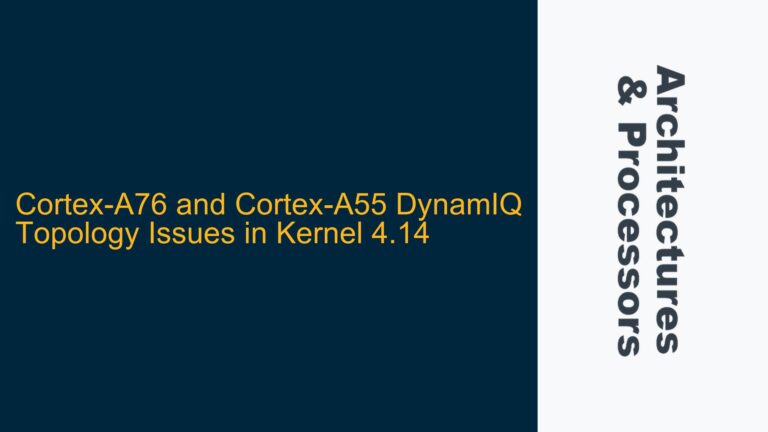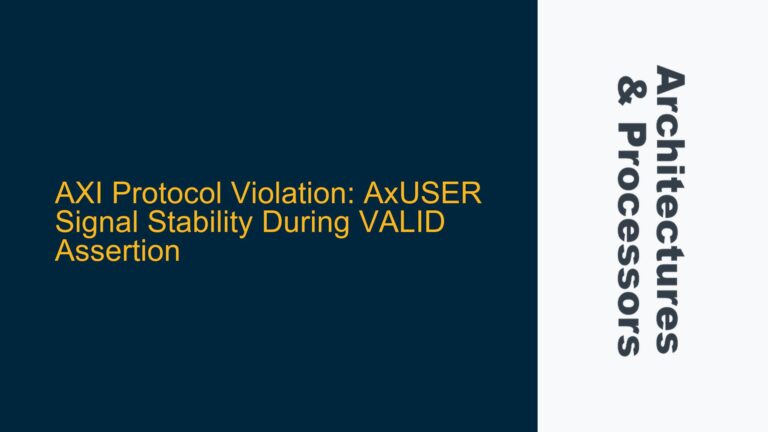ARM926EJ-S Illegal Instruction Error During Program Execution
The ARM926EJ-S processor, a member of the ARM9 family, is a widely used embedded processor known for its balance of performance and power efficiency. However, when running a simple "Hello World" program on a Linux-based system with kernel version 2.6.28, the program crashes with an "Illegal Instruction" error. This issue arises despite the program being compiled with the correct toolchain and flags, including -mcpu=arm926ej-s, -mfloat-abi=soft, and -mthumb. The error suggests that the processor is encountering an instruction it cannot execute, which is unexpected given the correct compilation flags and the processor’s architecture.
The ARM926EJ-S core supports the ARMv5TE instruction set, which includes both ARM and Thumb instruction sets. The Thumb instruction set is a compressed form of the ARM instruction set, designed to improve code density. The -mthumb flag instructs the compiler to generate Thumb instructions, which should be fully compatible with the ARM926EJ-S core. However, the "Illegal Instruction" error indicates that the processor is encountering an instruction that is not part of the ARMv5TE instruction set, or that the instruction is being executed in an inappropriate context.
The program in question is a simple C++ application that prints "Hello World" in an infinite loop. The code includes an inline assembly instruction __asm__ __volatile__ ("" : : : "memory"); which acts as a memory barrier, ensuring that memory operations are not reordered across this point. This barrier is typically used to prevent compiler optimizations that could lead to incorrect behavior in multi-threaded or hardware-interaction scenarios. However, in this case, the memory barrier does not resolve the "Illegal Instruction" error.
Toolchain Mismatch and Instruction Set Compatibility Issues
The root cause of the "Illegal Instruction" error is likely related to a mismatch between the toolchain used for compilation and the actual capabilities of the ARM926EJ-S processor. The toolchain in use is the GNU Toolchain for the A-profile Architecture, version 8.2-2018.08, which is designed for ARM processors supporting the ARMv7-A and later architectures. While the -mcpu=arm926ej-s flag specifies the target processor, the toolchain itself may still generate instructions that are not fully compatible with the ARMv5TE instruction set supported by the ARM926EJ-S.
The ARMv5TE instruction set includes both ARM and Thumb instruction sets, but it does not include some of the newer instructions introduced in ARMv7-A and later architectures. The GNU Toolchain for the A-profile Architecture may generate these newer instructions, even when targeting the ARM926EJ-S, leading to the "Illegal Instruction" error. Additionally, the use of the -mthumb flag may further complicate the situation, as the Thumb instruction set has evolved significantly between ARMv5TE and ARMv7-A.
Another potential issue is the use of the -mfloat-abi=soft flag, which specifies that software floating-point emulation should be used. While this flag is appropriate for the ARM926EJ-S, which does not have a hardware floating-point unit, it may interact poorly with other compiler flags or the toolchain itself. The combination of -mthumb, -mcpu=arm926ej-s, and -mfloat-abi=soft may lead to the generation of instructions that are not fully compatible with the ARM926EJ-S.
Resolving Toolchain Mismatch and Ensuring Instruction Set Compatibility
To resolve the "Illegal Instruction" error, it is essential to ensure that the toolchain used for compilation is fully compatible with the ARM926EJ-S processor and its ARMv5TE instruction set. The following steps outline the process for achieving this:
-
Use a Compatible Toolchain: The first step is to switch to a toolchain that is specifically designed for the ARMv5TE architecture. The GNU Toolchain for the A-profile Architecture is not suitable for this purpose, as it targets ARMv7-A and later architectures. Instead, use a toolchain that is explicitly designed for ARMv5TE, such as the GNU Toolchain for the ARM Architecture (arm-none-eabi). This toolchain includes support for the ARMv5TE instruction set and can generate code that is fully compatible with the ARM926EJ-S.
-
Verify Compiler Flags: Ensure that the compiler flags are correctly set to target the ARM926EJ-S processor. The
-mcpu=arm926ej-sflag should be used to specify the target processor, and the-mfloat-abi=softflag should be used to enable software floating-point emulation. The-mthumbflag should be used with caution, as it may generate Thumb instructions that are not fully compatible with the ARM926EJ-S. If the-mthumbflag is used, ensure that the generated Thumb instructions are part of the ARMv5TE instruction set. -
Disassemble the Binary: Use the
objdumptool to disassemble the binary and inspect the generated instructions. This will help identify any instructions that are not part of the ARMv5TE instruction set. The disassembly can be performed using the following command:arm-none-eabi-objdump -d Test > Test.disReview the disassembled code to ensure that all instructions are part of the ARMv5TE instruction set. Pay particular attention to any instructions that are not recognized by the ARM926EJ-S, as these may be the cause of the "Illegal Instruction" error.
-
Modify Compiler Flags: If the disassembly reveals instructions that are not part of the ARMv5TE instruction set, modify the compiler flags to prevent the generation of these instructions. For example, if the
-mthumbflag is generating incompatible Thumb instructions, remove the flag and recompile the code using only ARM instructions. Alternatively, use the-marmflag to explicitly generate ARM instructions. -
Test the Modified Binary: After modifying the compiler flags and recompiling the code, test the modified binary on the ARM926EJ-S board. If the "Illegal Instruction" error is resolved, the issue was likely due to incompatible instructions generated by the toolchain. If the error persists, further investigation may be required to identify other potential causes.
-
Consider Using an Older Toolchain: If the above steps do not resolve the issue, consider using an older version of the GNU Toolchain that is known to be compatible with the ARMv5TE architecture. Older versions of the toolchain may generate code that is more compatible with the ARM926EJ-S, as they were designed before the introduction of newer ARM architectures.
-
Check for Inline Assembly Issues: If the program includes inline assembly code, ensure that the assembly instructions are compatible with the ARMv5TE instruction set. Inline assembly can bypass the compiler’s checks and generate instructions that are not supported by the target processor. Review the inline assembly code and modify it if necessary to ensure compatibility with the ARM926EJ-S.
-
Verify Memory Barrier Usage: The use of memory barriers, such as
__asm__ __volatile__ ("" : : : "memory");, should be carefully reviewed. While memory barriers are useful for preventing compiler optimizations that could lead to incorrect behavior, they should not be used unnecessarily. Ensure that the memory barrier is required for the specific use case and that it does not interfere with the correct execution of the program.
By following these steps, the "Illegal Instruction" error can be resolved, ensuring that the program runs correctly on the ARM926EJ-S processor. The key is to use a compatible toolchain, verify the generated instructions, and ensure that all compiler flags and inline assembly code are appropriate for the target architecture.






